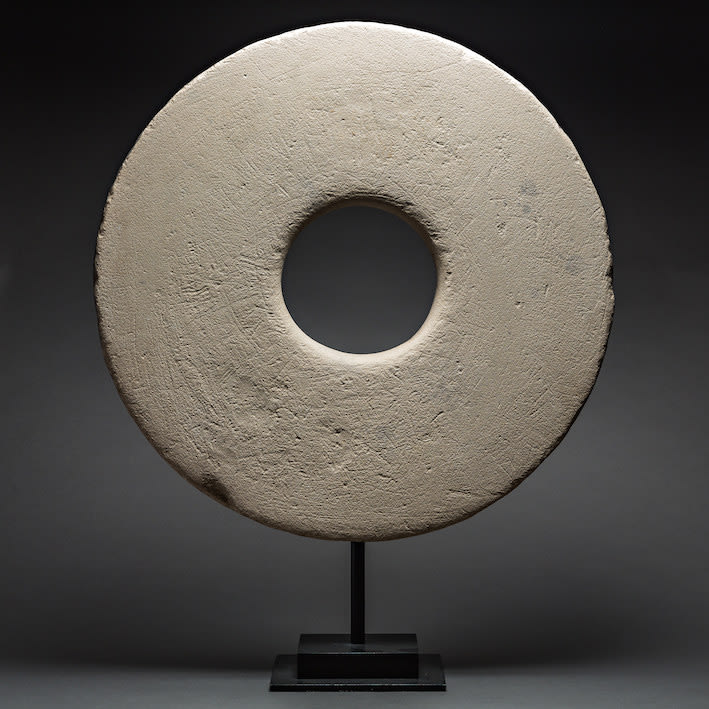Rai Stone (Micronesian Currency), 1600 CE - 1900 CE
Limestone
61 x 61 cm
24 x 24 in
24 x 24 in
SF.313 (LSO)
This remarkable object is one of the world’s rarest forms of currency – a Micronesian (Yapese) Rai stone. It is one of a range of items that are used as...
This remarkable object is one of the world’s rarest forms of currency – a Micronesian (Yapese) Rai stone. It is one of a range of items that are used as money in this part of the world; more portable forms include shell necklaces (such as those used in the famous “Kula Ring” exchange network system) and sharks teeth. It is perhaps peculiar to note that these items, which are also the largest standardised currency ever to have existed, have to be borne to and fro on tiny outrigger canoes, in which the Micronesians have gained a justified reputation as the world’s greatest navigators. Yet this is part of the reason for their value. Yap itself is made primarily of shale, which is unsuitable for carving. The nearest stone worthy of the name is to be found in the islands of Palau, which are about 700 miles away, and which were discovered by a Yapese man named Anagumang about 600 years ago.
Having abandoned the first shape that occurred to him – a fish – Anagumang ordered his men to cut hollow, round shapes instead. These were transported back to Yap and their rarity made them extremely valuable. Yet their value is both intrinsic and extrinsic, and calculated on the basis of factors including size, quality of craftsmanship, how difficult it was to transport, how many people (if any) died during its transport, and even the identity of the sailor who brought it in: the more famous the sailor, the higher the value. The largest limestone disk, believed to have been more than eight feet in diameter, might have been valued greater than an entire village. They were displayed outside houses or on top of graves, but some, especially the largest ones, were rarely moved. Rai stones were mostly used in social transactions such as marriage contracts, inheritance, political deals, as a sign of an alliance and funerals. The new owners always recorded the names of the previous owners; thus the stones – locally known as “fei” – became part of a localised mythology that plots the history of the Yapese people.
This form of currency was threatened in the late 19th century when the Irish-American captain David O’Keefe was shipwrecked on the Island of Yap in 1878. After discovering the local demand for these objects he introduced modern, European nautical stonecutting technology to produce and transport the stones more efficiently. The stones continued to be used through various European administrations but their use as a standard form of currency ceased in the 1960s due to trade disputes between Spanish and German interests in the area. They have since been replaced as everyday currency by more conventional forms of coinage. However, they are still used in a largely ceremonial manner, especially for honouring of marriage contracts and other such dealings.
The popularity of these pieces means that they can no longer be exported from Yap; the number of fei in private hands is therefore finite, and most are in major institutions (notably the British Museum). The powerful geometric presence of the piece is harmonious and impressive, and in tune with modern interiors and design. Equally, this piece is of the perfect size for private ownership, and will be an aesthetically magnetic and historically fascinating focal point in any collection or sophisticated domestic setting.
Having abandoned the first shape that occurred to him – a fish – Anagumang ordered his men to cut hollow, round shapes instead. These were transported back to Yap and their rarity made them extremely valuable. Yet their value is both intrinsic and extrinsic, and calculated on the basis of factors including size, quality of craftsmanship, how difficult it was to transport, how many people (if any) died during its transport, and even the identity of the sailor who brought it in: the more famous the sailor, the higher the value. The largest limestone disk, believed to have been more than eight feet in diameter, might have been valued greater than an entire village. They were displayed outside houses or on top of graves, but some, especially the largest ones, were rarely moved. Rai stones were mostly used in social transactions such as marriage contracts, inheritance, political deals, as a sign of an alliance and funerals. The new owners always recorded the names of the previous owners; thus the stones – locally known as “fei” – became part of a localised mythology that plots the history of the Yapese people.
This form of currency was threatened in the late 19th century when the Irish-American captain David O’Keefe was shipwrecked on the Island of Yap in 1878. After discovering the local demand for these objects he introduced modern, European nautical stonecutting technology to produce and transport the stones more efficiently. The stones continued to be used through various European administrations but their use as a standard form of currency ceased in the 1960s due to trade disputes between Spanish and German interests in the area. They have since been replaced as everyday currency by more conventional forms of coinage. However, they are still used in a largely ceremonial manner, especially for honouring of marriage contracts and other such dealings.
The popularity of these pieces means that they can no longer be exported from Yap; the number of fei in private hands is therefore finite, and most are in major institutions (notably the British Museum). The powerful geometric presence of the piece is harmonious and impressive, and in tune with modern interiors and design. Equally, this piece is of the perfect size for private ownership, and will be an aesthetically magnetic and historically fascinating focal point in any collection or sophisticated domestic setting.



